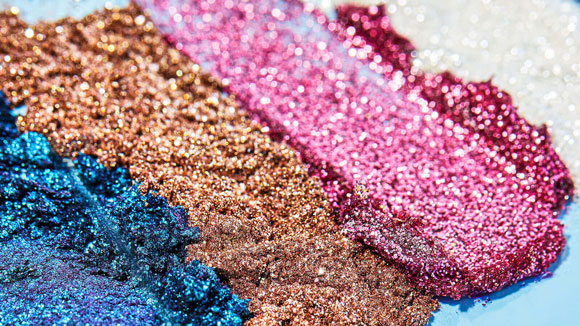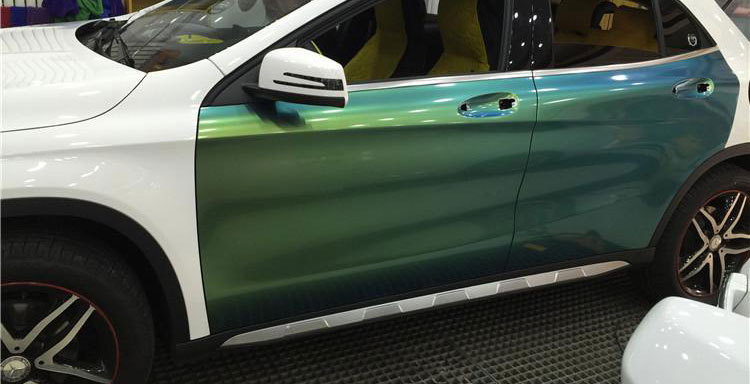categories
recent posts
What is a Pearlescent Pigment?
Pearlescent pigments are coated mica platelets that provide both color and exciting visual effects to a variety of coatings, plastics and printing ink. These luster pigments are transparent and because of their smooth surfaces reflect light. Light reflected from the platelets creates a sense of depth and a luster that varies with particle size—smaller particles impart a satin sheen while larger particles create sparkle or glitter. Some pearlescent pigments are iridescent showing luminous colors that seem to change when seen from different angles. Although these pigments are non-metallic, they can give paint a metallic look. Almost all pearlescent pigments are non-reactive and nontoxic.
The mica of pearlescent pigments are synthetic or natural that have been coated with titanium dioxide, iron oxide or another metal oxide. Platelets of coated mica can vary in size, shape and thickness. It is the degree of these characteristics along with the thickness of the coating that determine the color and appearance of the pigment. Additionally, thickness and the coarseness of the particles determine the sparkle.
The term "pearlescent pigment" derives from natural pearl and mother-of-pearl. These materials comprise layers that reflect some light while remaining translucent enough to allow light to pass further below the surface. Light is reflected back to reach the observer from several layers, including the top layer, creating a lustrous appearance of reflected light and depth.
Pearlescent, or nacreous pigments, come from either natural sources, such as fish scales or synthetic sources (i.e., metal oxide coated micas, bismuth oxychloride, basic lead carbonate, lead arsenate, etc.).
While conventional metallic pigments are essentially planar flakes of an opaque reflective material, pearlescent and other effect pigments use a multi-layer structure to produce reflection, refraction, and optical interference.
Pearlescent pigment grades include silver (white), interference colors (yellow, orange, red, violet, blue, green), earth tone colors (bronze, copper, russet), and gold colors (light gold and gold).
Mica is a natural mineral (muscovite) of low refractive index (RI) that is transparent in paint, because it allows the transmission of light. When these thin platelets (about 500 nm) are coated with high refractive index metal oxides (ranging in thickness from 60 to 165 nm) they have the ability to reflect light. The face size of these particles range from 1 to 150 microns and the thickness ranges from 0.1 to 3 microns.

What is Luster and Glitter?
Luster is a gentle sheen or soft glow, resulting from a substance that is partly transparent and with a partly reflective surface. The reflective property of minerals with vitreous luster is similar to that of glass. This is a very common type of luster and can occur in minerals that are transparent or translucent, such as quartz and calcite.
The glitter or sparkle effect of some pearlescent pigments is its ability to shine by reflection with many small flashes of brilliant light.
Rublev Colours Copper Pearlescent pigment is non-toxic and FDA approved for use in personal care products and cosmetics.
How Pearlescent Pigments Work
White light is the name given to light that makes up all colors of the spectrum. When we see something as a blue pigment, we are seeing the reflection of blue light. When we see something as a red pigment, we are seeing the reflection of red light.
Mica platelets have a high level of transparency. Meaning white light will pass through the platelet. The titanium dioxide layer as a higher refraction index than the mica and the surrounding. Light is refracted and at the interfaces reflected in different angles. By this phase shift so called interference colors—the main characteristic of a pearlescent effect—are created. Iron oxide shows its typical color even in thin layers on a mica substrate.
Manipulating the metal oxide and its thickness allows formulators to fine-tune the reflection of specific wavelengths of light, creating custom and unique colors. Small changes in the platelet can have a large impact on the pigment and colors that are visible.

What Are the Characteristics of Pearlescent Pigment?
In addition to the thickness and type of metal oxide, pearlescent pigments have different and defined characteristics that will determine the color.
· Platelet Size—The size of the mica.
· Particle Size Distribution—A characteristic composition of fine and coarse particles leading to the PSD curve.
· Platelet Orientation—The direction the mica particles are facing.
· Pigment Concentration—The amount of pigment added to the base.
· Film Transparency—Transmission of unobstructed light through the film.
Combining pearlescents with other pigments is as much art as science, given the complexity of how their colors interact. The interference colors formed by pearlescent pigments add when mixed so that red and blue form magenta, blue and green form blue-green, and red and green form yellow. White results when the three primary colors are mixed in the right proportion. By contrast, absorption colors created by other pigments subtract when mixed so that yellow and blue form green, red and yellow form orange, and red and blue form violet. Black results when the three primaries are mixed in the right proportion. Note that the primary and secondary colors are different for additive and subtractive colors.
In additive mixing, complementary colors mix to form white. In subtractive mixing, they mix to form gray or black.
What Is the Difference between Pearlescent and Iridescent?
Iridescence (also known as goniochromism) is the phenomenon of certain surfaces that appear to gradually change color as the angle of view or the angle of illumination changes. Examples of iridescence include soap bubbles, feathers, butterfly wings and seashell nacre, as well as certain minerals. It is often created by structural coloration (microstructures that interfere with light).
Pearlescence is a related effect where some or all of the reflected light is white, where iridescent effects produce only other colors. The term pearlescent is used to describe certain paint finishes, usually in the automotive industry, which actually produce iridescent effects.
Orientation
Maximum reflection and color travel are only achieved when the platelets are uniformly oriented parallel to the substrate. This is achieved primarily by film shrinkage and leveling of the coating while it is drying. It can also be affected by the size of the particles.
Film shrinkage is directly related to the total solids of the coating. Low-solids coatings shrink more than high-solids coatings, thereby improving the orientation and color travel. This is one of the primary reasons why high-solids coatings containing mica are a different color versus low-solid, waterborne paint, even though the pigmentation is the same. Better pigment dispersion, slow evaporating solvents used in the coating formulation, longer flashing time, or a ladder baking schedule will also improve orientation of the pigments and achieve maximum luster. Figure 6 demonstrates this influence of two different solids formulations.
the professional team to service !